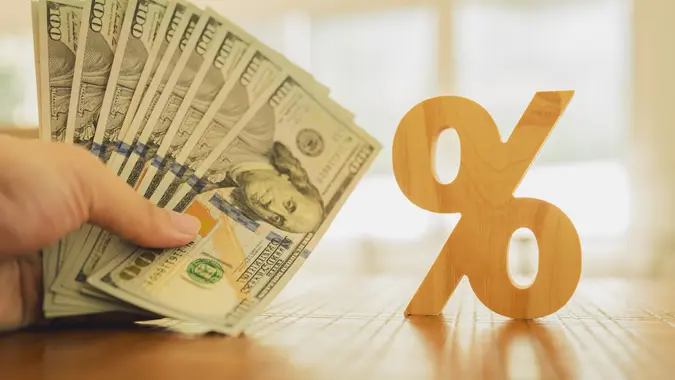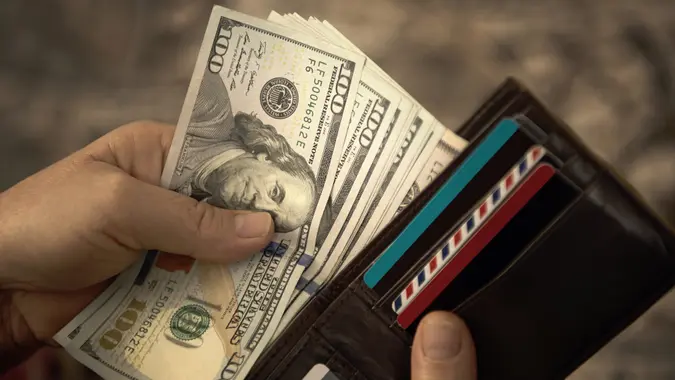How To Allocate Parts of Your Paycheck for Intermittent Luxury Splurges

Commitment to Our Readers
GOBankingRates' editorial team is committed to bringing you unbiased reviews and information. We use data-driven methodologies to evaluate financial products and services - our reviews and ratings are not influenced by advertisers. You can read more about our editorial guidelines and our products and services review methodology.

20 Years
Helping You Live Richer

Reviewed
by Experts

Trusted by
Millions of Readers
Saving money is great, but every now and then, you just need that fancy dinner, weekend getaway or limited-edition gadget. But with recession fears rocking the stock market, as reported by CNN, it can be hard to think of indulging. The good news? You can absolutely treat yourself without blowing your budget. It all comes down to planning.
Here are some ways to carve out a piece of your paycheck for those well-deserved luxury splurges — guilt-free.
How To Budget for Intermittent Luxury Spending
Luxury splurges don’t have to derail your financial goals — as long as you plan for them. The key is to treat luxury like any other budget category.
For example, set aside a small percentage of your paycheck — say, 5% to 10% — into a separate “luxury” or “treat yourself” fund. This way, when something special catches your eye or you’re in the mood for a little indulgence, you’ve already got the cash set aside.
“I’ve found the sweet spot is setting aside 5% to 10% of each paycheck specifically for luxury splurges,” said Andrew Lokenauth, money expert and owner of BeFluentInFinance. “The thing is, you’ve gotta be disciplined about it.”
He keeps a separate savings account called his “treat yourself fund” and automatically transfers $200 from each paycheck right when it hits. This way the money’s already earmarked for something special and he doesn’t feel guilty when he eventually spends it.
“Last December, I saved up enough for a weekend at this amazing resort in Sedona,” he added.
Lokenauth said the satisfaction of paying cash (instead of racking up credit card debt) made those infinity pool views even sweeter. And because he’d planned for it, there wasn’t that usual post-splurge anxiety.
It’s all about balance: enjoy the finer things, without sacrificing your financial peace of mind.
Making It Work Within Your Overall Financial Picture
Here’s the critical part — intermittent luxury only works if your basic financial house is in order first. Luxury spending should never come at the expense of your essentials or long-term goals.
Before setting aside money for splurges, make sure your financial basics are covered: bills, savings, debt payments and emergency fund contributions. Once those are in place, you can figure out what’s left for the fun stuff.
Lokenauth makes sure his emergency fund has six months of expenses, his 401(k) contribution is at least 15% and he’s got no credit card debt.
“Then and only then do I give myself permission to save for the fun stuff,” he explained.
He said sometimes he’ll boost his luxury savings by picking up extra projects at work or selling stuff he doesn’t need anymore.
The extra hustle makes the eventual reward feel even better.
Anticipating and planning for these occasional splurges helps him stay motivated during long stretches of being disciplined with his money.
Creating Your Intermittent Luxury Strategy
Start by deciding what “luxury” means to you. It could be quarterly spa days, designer sneakers, gourmet dining or tech upgrades. Whatever it is, define your splurge goals so you know what you’re saving for.
Next, figure out your timeline. Are you aiming for a treat every month? Every quarter? Set a realistic frequency based on your income and other financial obligations.
Based on Lokenauth’s experience helping others with their finances, he said the best approach is starting small.
He recommended beginning with setting aside 3% of your income and gradually increasing it as your salary grows. He’s seen too many people try to go too big too fast and end up frustrated.
The key is being super specific about what counts as a luxury splurge. For Lokenauth, anything over $500 that isn’t a necessity goes into this category.
Having that clear definition keeps him from using his luxury fund for random impulse purchases.
“Trust me, I learned that lesson the hard way,” Lokenauth said.
Making It Sustainable Long-Term
The key to luxury spending that doesn’t throw your finances off track? Consistency and self-awareness.
Building a sustainable strategy means checking in with your habits every so often. Are you still hitting your savings goals? Are your splurges still bringing you joy — or just becoming routine?
One thing that’s worked well for Lokenauth, is tracking how these occasional luxuries impact his overall happiness compared to regular small indulgences.
He said those special experiences or items — when properly spaced out — bring him way more joy than the same amount spent on frequent smaller treats.
At the same time, he also makes sure to build in a buffer for unexpected opportunities.
“Sometimes amazing deals come up and having that dedicated luxury fund means I can jump on them without messing up my regular budget,” he said. “Last month, I snagged some seriously discounted first-class tickets because I had the funds ready to go.”
More From GOBankingRates
 Written by
Written by  Edited by
Edited by 

























